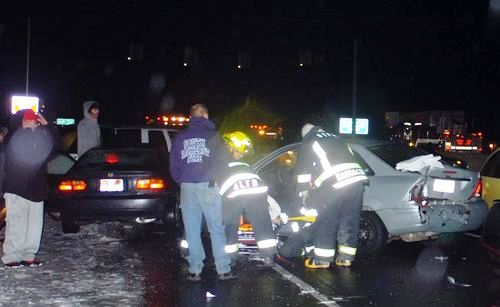The Detroit Bureau
Emergency teams struggle to save young people in a nighttime accident involved.
By Paul A. Eisenstein, the Detroit Bureau
Motor vehicle crashes are the leading cause of death for U.S. teens, according to government statistics, but a new insurance industry report suggests that the numbers could sink, by restrictions on teen drivers tighten laws.
Car crashes for one of three people responsible reported among young people are for highway safety projects that could be saved through the use of more restrictive licenses annually at least 500 lives every year the Centers for disease control, but the new study of insurance. In some Member States, which IIHS said it expected the mortality rate among teen drivers of less than 50% fall.
The new study emphasised it best-practice guidelines adopted, called from various Member States, including driving a ban with Teen passengers, limited night rides and a request for the supervised.
Ford to offer 98,000 pensioners of buyouts
"Even the best States can do better", says Anne McCartt, senior Vice President for research at IIHS. "There is room for improvement in all areas, and States could see claims immediate reduction in fatal crashes and collision, once regulations are in place to strengthen."
States with the toughest constraints the sharpest decline in teen of fatalities compared to those with less restrictive policy signed the IIHS reported. The Institute isolated five specific policies which seem to help:
Later driving age, 17 in New Jersey;They allow later age 16 in district of Columbia, New York, Massachusetts, Delaware, and five other States;At least 65 hours of supervised driving in Pennsylvania;Night driving ban in Idaho, South Carolina; AndA ban teen passengers in 15 States and Washington, D.C.
The IIHS report indicates that all but nine States now have to allow so-called graduated driver's licenses or GDLs, the young people to build up experience and maturity behind the wheel. There are three levels: a period of supervised driving under a learner who allow, meanwhile licensing, certain restrictions, followed by a license that manages full permissions.
Chevrolet inks deal with Manchester United
Since the year 2000, the IIHS has been assessed the various countries according to the effectiveness of their teen driving regulations. Initially only six States and D.C. evaluation "Good". Today however is the up to 36 States and district. Another seven earn now "faire" reviews, with seven other rated "Marginal."
But the IIHS says that the steam run the transition to more stringent restrictions has and it move to state legislators to act a new strategy that moves the public get a sense of how many lives could, with stricter rules be saved. Click here , to the computer on the IIHS Web site access.
"States have to not the toughest laws in the nation Security realize profits." Strengthening pays off one or two components. To maximize all the benefits of tiered licensing but we encouraged legislators to consider, "McCartt says the strongest provisions."
Lenders loosen car loans
South Dakota, could for example see a full 63% drop in fatal crashes, the IIHS projects and a decline in the collision claims by 37%.
Even States which have adopted many of the proposed restrictions, could be better, says McCartt. By the further increase of his age minimum license, increasing driving hours monitored and drive a night add constraint, the insurance would trade group projects Connecticut of a 17% drop in fatal crashes and 13% reduction in claims see collision.
McCartt recognizes that while further restrictions it supports may be difficult is the evidence that legislators Act taking into account the proposals are always "politically popular."







0 коммент.:
Post a Comment